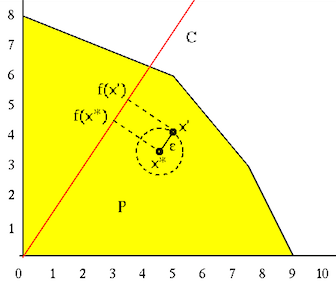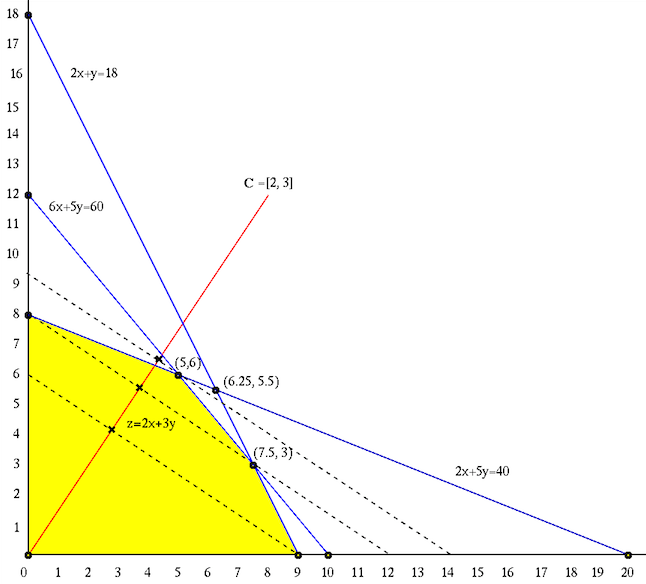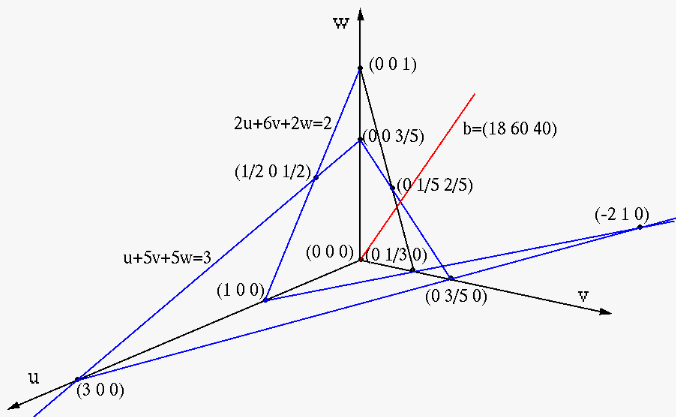Next: The Simplex Algorithm Up: Constrained Optimization Previous: Duality and KKT Conditions
The basic problem in linear programming (LP) is to minimize/maximize a
linear objective function




 |
(209) |
The LP problem can be more concisely represented in matrix form:
where![$\displaystyle {\bf x}=\left[\begin{array}{c}x_1\\ \vdots\\ x_N\end{array}\right...
...ts&a_{1N}\\
\vdots & \ddots & \vdots \\ a_{M1}&\cdots&a_{MN}\end{array}\right]$](img789.svg) |
(211) |
For example, the objective function could be the total profit,
the constraints could be some limited resources. Spicifically,






Here all variables are assumed to be non-negative. If there exists a variable that is not restricted, it can be eliminated. Specifically, we can solve one of the constraining equations for the variable and use the resulting expression of the variable to replace all its appearances in the problem. For example:
 |
(212) |
 , we get
, we get
 . Substituting this into the objective
function and the other constraint, we get
. Substituting this into the objective
function and the other constraint, we get
 and
and
 , the problem can be reformulated as:
, the problem can be reformulated as:
 |
(213) |
Given the primal LP problem above, we can further find its dual problem. We first construct the Lagrangian of primal problem:
 |
(214) |
![${\bf y}=[y_1,\cdots,y_M]^T$](img800.svg) contains the Lagrange multipliers
for the inequality constraints
contains the Lagrange multipliers
for the inequality constraints
 , and
, and
 according to Table 188. We
define the dual function as the maximum of
according to Table 188. We
define the dual function as the maximum of
 over
over
 :
:
![$\displaystyle f_d({\bf y})=\max_{\bf x} L({\bf x})
=\max_{\bf x} [ {\bf c}^T{\b...
...bf b}) ]
=\max_{\bf x} [ ({\bf c}-{\bf A}^T{\bf y})^T{\bf x}+{\bf y}^T{\bf b} ]$](img804.svg) |
(215) |
 that maximizes
that maximizes
 , we set
its gradient to zero and get:
, we set
its gradient to zero and get:
![$\displaystyle \bigtriangledown_{\bf x}L({\bf x})
=\bigtriangledown_{\bf x}[ ({\...
...}-{\bf A}^T{\bf y})^T{\bf x}+{\bf y}^T{\bf b}]
={\bf c}-{\bf A}^T{\bf y}={\bf0}$](img805.svg) |
(216) |
 we get:
we get:
 , which is the upper bound of
, which is the upper bound of
 , under the constraint that
, under the constraint that
 so that
so that
 contributes negatively
to
contributes negatively
to
 (as
(as
 ):
):
 |
(217) |
 ,
to become the tightest upper bound, i.e., the original primal
problem of maximization in Eq. (210) has now been converted
into the following dual problem of minimization:
,
to become the tightest upper bound, i.e., the original primal
problem of maximization in Eq. (210) has now been converted
into the following dual problem of minimization:
 |
(218) |
 |
(219) |
If either the primal or the dual is feasible and bounded, so is
the other, and they form a strong duality, the solution 

An inequality constrained LP problem can be converted to an equality constrained problem by introducing slack variables:
 |
(220) |
 |
(221) |
 is an
is an  dimensional augmented variable vector that
includes the
dimensional augmented variable vector that
includes the  slack variables
slack variables
 as well as the
as well as the
 original variables
original variables
 :
:
![$\displaystyle {\bf x}=[x_1,\;x_2,\cdots,x_N,\,s_1,\;s_2,\cdots,s_M]^T$](img823.svg) |
(222) |
 is redefined as an
is redefined as an
 augmented coefficient
matrix that includes coefficients for both types of variables:
augmented coefficient
matrix that includes coefficients for both types of variables:
![$\displaystyle {\bf A}=\left[\begin{array}{cccc\vert cccc}
a_{11} & a_{12} & \cd...
...\right]_{M\times (N+M)}
=[\;{\bf A}_{M\times N}\;\vert\; {\bf I}_{M\times M}\;]$](img825.svg) |
(223) |
 are the coefficients for the
are the coefficients for the  original variables
original variables
 , and the identity matrix
, and the identity matrix
![${\bf I}_{M\times M}=[{\bf e}_1,\cdots,{\bf e}_M]$](img827.svg) is for the unity
coefficients of the
is for the unity
coefficients of the  slack variables
slack variables
 ,
each of which appears in the
,
each of which appears in the  constraints only once.
constraints only once.
Now the LP problem can be expressed in the standard form (original form
on the left, with 

 or or |
(224) |
An LP problem can be viewed geometrically. If normalize







![${\bf a}_j=[a_{i1},\cdots,a_{IN}]^T$](img833.svg)
 |
(225) |
 non-negativity conditions
non-negativity conditions  in
in
 corresponds to a hyper-plane perpendicular
to the jth standard basis vector
corresponds to a hyper-plane perpendicular
to the jth standard basis vector  . In general, in an
N-D space, if none of the hyper-planes is parallel to any others,
then no more than
. In general, in an
N-D space, if none of the hyper-planes is parallel to any others,
then no more than  hyper-planes intersect at one point. For
example, in a 2-D or 3-D space, two straignt lines or three
surfaces intersect at a point. Here for the LP problem in the
N-D space, the total number of intersection points formed by
the
hyper-planes intersect at one point. For
example, in a 2-D or 3-D space, two straignt lines or three
surfaces intersect at a point. Here for the LP problem in the
N-D space, the total number of intersection points formed by
the  hyper-planes is
hyper-planes is
 |
(226) |
The polytope enclosed by these 

Fundamental theorem of linear programming
The optimal solution 


Proof:
Assume the optimal solution






 |
(227) |
 |
(228) |
 cannot be the optimal solution as assumed. This contradiction
indicates that an optimal solution
cannot be the optimal solution as assumed. This contradiction
indicates that an optimal solution  must be on the surface of
must be on the surface of  ,
either at one of its vertices or on one of its surfaces. Q.E.D.
,
either at one of its vertices or on one of its surfaces. Q.E.D.
Based on this theorem, the optimization of a linear programming problem
could be solved by exhaustively checking each of the 










Example:
 or or |
![$\displaystyle {\bf x}=\left[\begin{array}{c}x_1\\ x_2\end{array}\right],\;\;\;\...
...ight],\;\;\;\;
{\bf A}=\left[\begin{array}{cc}2&1\\ 6&5\\ 2&5\end{array}\right]$](img847.svg) |

This problem has 




![${\bf x}=[x_1,\;x_2]^T$](img852.svg)
![${\bf c}=[2,\;3]^T$](img853.svg)







This LP problem can be converted into the standard form:
 |
Listed in the table below are the









 |
This primal maximization problem can be converted into the dual minimization problem:
 or or |
The five planes, 





 |
We see that at the feasible point






Homework:
Develop the code to find all 




